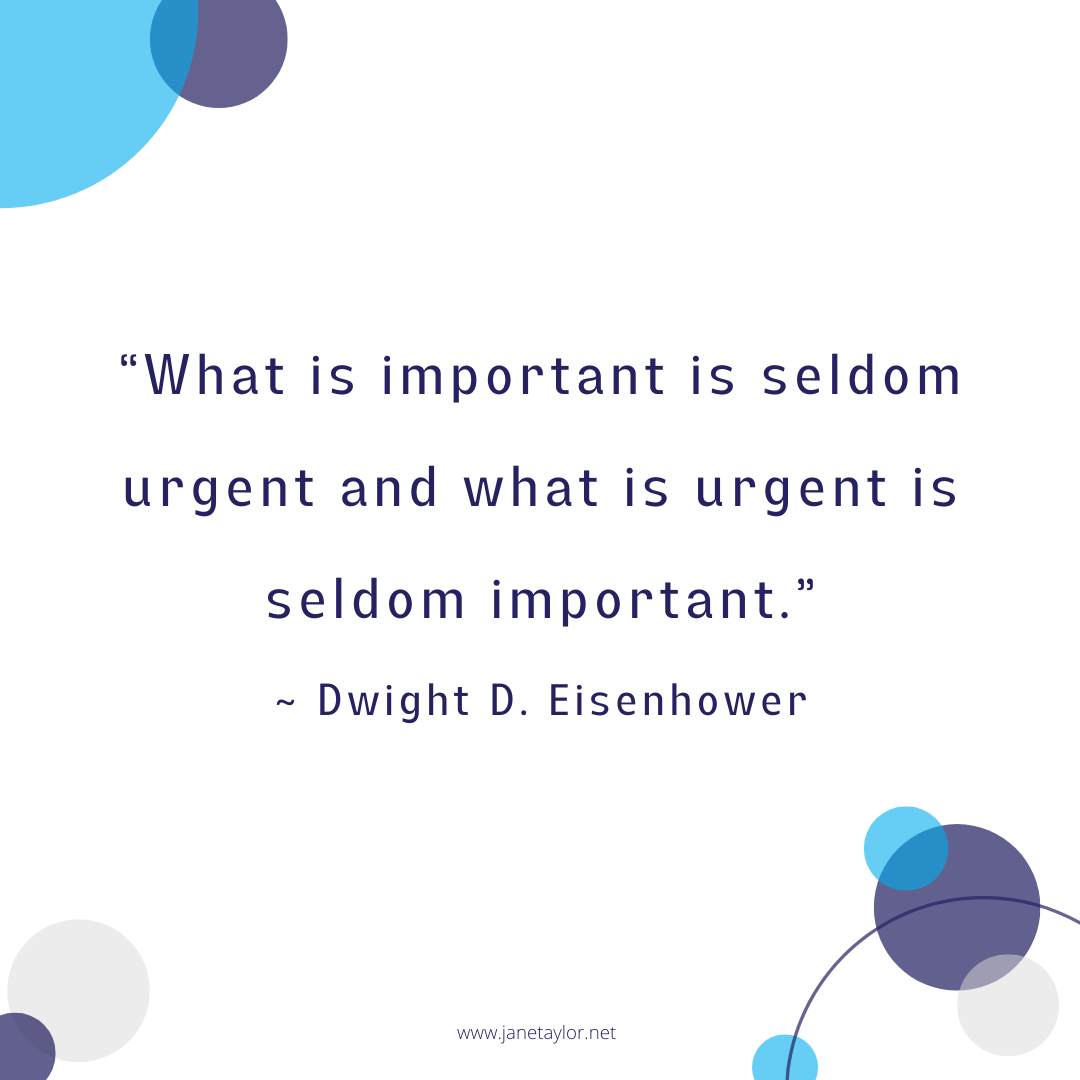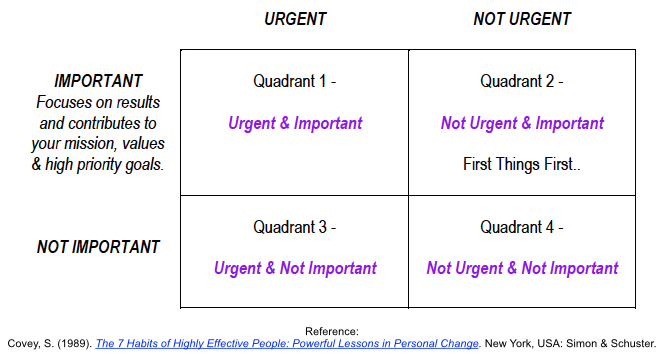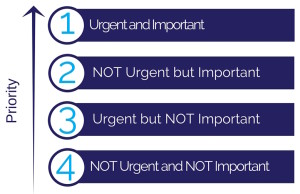Priorities – The Difference Between Urgent and Important Tasks

Dwight D. Eisenhower was the 34th President of the United States and the following quote has been linked to him – “What is important is seldom urgent and what is urgent is seldom important.” This quote led to the Eisenhower Decision Matrix.
This week I had a situation where it helped me further clarify the difference between urgent and important. Before I talk about the difference between urgent and important, let’s look at the Eisenhower Decision Matrix.
The Eisenhower Decision Matrix

As you can see in the following diagram of the Eisenhower Decision Matrix (which has also been attributed to Stephen Covey), the matrix is divided in to four quadrants.
Quadrant 1 – Urgent and Important:
In Q-1 we deal with the urgent and the important – significant results that require urgent attention. For example – crisis, problems and/or emergencies. We all have these in our lives, however the difference is people who are mainly in Q-1 it is the focus of their life. Some examples of urgent and important tasks include –
- tax deadline,
- paying expenses,
- an accident or emergency, and
- being at the airport on time for a flight.
What else can you think of for you?
Some of the results of spending too much of our time here include burnout, stress and continually just putting out fires instead of being proactive.
Quadrant 2 – Not Urgent and Important:
In Q-2 we deal with the not urgent and important. This quadrant it the heart of effective personal management. Some examples of activities in this quadrant include –
- building relationships,
- writing a personal mission statement,
- nurturing your health (i.e. yoga, drinking water),
- quarterly (84-day) planning,
- my CEO dates,
- planning, preparing and organising your food for the week, and
- activities you know you need to do to maintain your life (i.e expense plan for using money).
The results of spending time here include your focused on your vision, mission, what you can control, discipline and commitment. Many of these tasks for me are scheduled and part of my self-management process.
Quadrant 3 – Urgent and Not Important:
In Q-3 we deal with the urgent and not important. People who spend too much time in this quadrant, spend most of their time reacting to things that are urgent and assume important. Examples of some tasks that could be in this quadrant include –
- Some phone calls and texts,
- Some emails (although some could be in the other areas),
- People who drop-in unannounced wanting your help with a task, or
- Other people wanting our help to meet their goals and priorities.
Some of the results of spending too much in this quadrant include focusing on other people needs, feeling victimised, lack of focus on your goals, crisis management and shallow or broken relationships. Also – this quadrant can be a great place to delegate or minimise to limit the distractions.
Quadrant 4 – Not Urgent and Not Important:
In Q-4 we deal with the not urgent and not important.These activities are basically “wasting time” activities. Some examples of these types of activities include –
- mindlessly surfing the internet,
- scrolling through social media and losing track of time,
- spending sprees, or
- other types of activities that do not align to your own values or purpose.
The results of spending too much time in this area can be disengagement from life, irresponsibility and dependent on other people. For me personally, I try to eliminate or at least limit investing too much time here.
The Difference Between Urgent and Important Tasks
When we look at the words “urgent” and “important”, they have slightly different meanings. Urgent means – “requiring immediate action or attention” and important means – “necessary or of great value.” So why do confuse immediacy with value or worth?
This week the example that helped my further clarify the difference between urgent and important was a flat tyre. I got to my car to drive to yoga (which is important for me) to find that I had a flat tyre. I had already pumped up this tyre two weeks ago, so this moved the situation from important to urgent as I got a sense it was a nail and therefore the tyre needed replacing. Fortunately, the local tyre place could get me in and an hour later I had a new tyre. Yes I did miss my yoga class, however as it rained in the afternoon, my other appointment was cancelled and I got to go to yoga in the end.
Setting Priorities
One way to improving self-management is by prioritising your urgent and important. The diagram below gives you a guide for these priorities.

Over to You…
I hope this has given you some insight to the difference between urgent and important tasks. If you have any questions or comments, please leave them below.
If you are ready to reclaim your courage and take the next step towards freedom and opening your heart, why not join our Toolkit?
Reference –
Covey, S. (1989). The 7 Habits of Highly Effective People: Powerful Lessons in Personal Change. New York, USA: Simon & Schuster.
